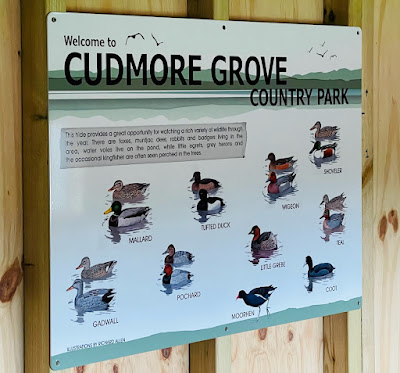A new information board with Richard Allen's excellent bird illustrations has been placed in the new bird hide at the park to help identify the wildfowl on the nearby pond.
On Tuesday the main ducks on the park pond were ten mallard and 25 teal.
At Maydays on Tuesday Martin Cock reported a peregrine, five marsh harriers, six red-breasted mergansers, a great northern diver in the Pyefleet, stonechat, rock pipit and seven corn buntings.
A male sparrowhawk has been a regular visitor to the Firs Chase garden recently, here staring at one of the bird feeders.
A male sparrowhawk has been a regular visitor to the Firs Chase garden recently, here staring at one of the bird feeders.
Earlier a goldcrest was seen in bushes in the garden feeding with a mixed tit flock.
Along the Strood seawall on Monday 28th good numbers of duck were resting along the channel with 250 wigeon and 350 teal counted. Also ten Mediterranean gulls, 40 avocets and 70 black-tailed godwits along the channel while a stonechat and ten linnets were on the fields.
In the Pyefleet at Maydays on Monday a great northern diver, female goldeneye, seven marsh harriers, six red-breasted mergansers and a tufted duck were seen by Martin Cock.A chilly but sunny walk on Sunday 28th along the north side of the Island provided views of lots of waders gathering on the mud after the tide dropped. Here at the top end of the Pyefleet near Bower Hall farm, there was a marsh harrier, sparrowhawk, ten black-tailed godwits, fifty teal and 20 linnets of note. At Reeveshall a short-eared owl was flushed off the seawall, as it sheltered from the cold northerly wind.
Along the Pyefleet was a great northern diver, ten red-breasted mergansers, 80 avocets, 100 golden plover while at Maydays were two stonechats, yellowhammer and 20 reed buntings. The black-throated diver was still in the Strood channel, also here were 200 dunlin, 300 golden plover, a marsh harrier while a noisy flock of 1000 brent geese flew off the fields on the Peldon side.
The highlight of a walk along the Maydays and Reeveshall seawall on Saturday 27th was a ringtail hen harrier flying low eastwards over the fields, also five marsh harriers, most on Langenhoe. In the Pyefleet were ten red-breasted mergansers, 190 shelduck, 3 greylag geese, 145 avocets, 300 golden plover and nine knot. In the fields were 100 chaffinches, ten corn buntings, 30 reed buntings, two stonechats and fifty linnets. A big flock of 2000+ wood pigeons was seen in the air over Shop Lane having flown up from the maize stubble near there.
The black-throated diver was still present on Friday 26th in the Strood channel near the last of the boat moorings, seen by Martin Cock.
The female stonechat was seen still feeding along the Strood seawall on Thursday 25th.
The female stonechat was seen still feeding along the Strood seawall on Thursday 25th.
The big excitement on Thursday for some lucky few was the sight of a white stork flying over the heads of four observers including Steve Entwistle and Trevor Hearn. The bird appeared to have come from the Strood Hill direction flying north-west over the seawall towards Copt Hall. It is assumed this is the same bird that has been seen in the Stanway and Abberton reservoirs for the last few weeks.
By chance Neil Mortimer also managed to see the white stork from his Strood Close garden near the Firs Chase caravan park late morning, as it was being mobbed by gulls and crows.
This is the first record of white stork on the Island.
The black-throated diver was still feeding among the boat moorings in the Strood channel on Thursday. Also in the channel were 400 wigeon, 300 teal, 45 avocets, 500 golden plover, two ringed plover while two marsh harriers, sparrowhawk and three grey herons were seen too. In the fields were 500 wood pigeons, 300 starlings, 50 linnets, 20 skylarks and three reed buntings.
Three corn buntings were also seen by Steve Entwistle along the Strood seawall, and later from the Bower Hall seawall he saw ten grey partridges and at Maydays seven red-legged partridges, redwing and meadow pipit were reported.
The appearance of the December moth in the trap in Firs Chase garden on Wednesday 24th, is probably the last moth of the year to be recorded here, caught on the 78th night of trapping this year.









No comments:
Post a Comment